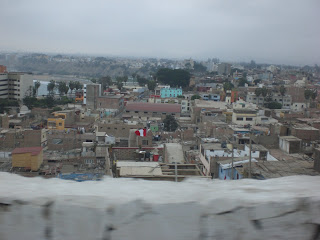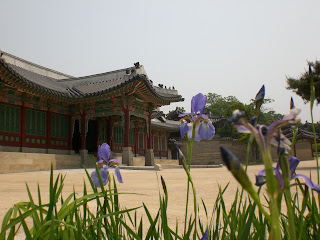 A hat vendor in Baranco, Lima's art district.
A hat vendor in Baranco, Lima's art district. Saturday, July 11, 2009
Around Lima
 A hat vendor in Baranco, Lima's art district.
A hat vendor in Baranco, Lima's art district. Friday, July 10, 2009
How NOT to find an Internet Cafe in Lima
Thursday, June 25, 2009
My Favorite Seoul Sightings
 We arrived during Yonsei's spring festival. Mechanical bull anyone? Photo by Erin Chapman.
We arrived during Yonsei's spring festival. Mechanical bull anyone? Photo by Erin Chapman. Korean truck stops are more like carnivals than truck stops. This little boy is eating fruit on a stick. Photo by Erin Chapman.
Korean truck stops are more like carnivals than truck stops. This little boy is eating fruit on a stick. Photo by Erin Chapman.  The steps in front of the Seoul National Art Museum. Photo by Erin Chapman.
The steps in front of the Seoul National Art Museum. Photo by Erin Chapman. The shrimp burger was not as good as the bulgolgi burger. Photo by Erin Chapman.
The shrimp burger was not as good as the bulgolgi burger. Photo by Erin Chapman.  South Korea is a place that truly appreciates musical theater. Consequently I love South Korea. Photo by Erin Chapman.
South Korea is a place that truly appreciates musical theater. Consequently I love South Korea. Photo by Erin Chapman. In Jeonju City we slept in a traditional Korean hut (aka on the floor with Spongebob blankets). Photo by Erin Chapman.
In Jeonju City we slept in a traditional Korean hut (aka on the floor with Spongebob blankets). Photo by Erin Chapman.  A young Korean couple sits in front of the light show above the Chungeychung river. Photo by Erin Chapman.
A young Korean couple sits in front of the light show above the Chungeychung river. Photo by Erin Chapman. Quintessentially Korean
 These street vendors were everywhere. The first night in Korea some members of our group ordered something, and the vendor handed them a long skinny black tube-shaped food. We are 90% sure it was stuff intestine. Photo by Erin Chapman.
These street vendors were everywhere. The first night in Korea some members of our group ordered something, and the vendor handed them a long skinny black tube-shaped food. We are 90% sure it was stuff intestine. Photo by Erin Chapman.
Wednesday, June 24, 2009
The Korean Miracle
I went to Korea to find out about Christianity and its affect on policy in Korea. Here's an excerpt from the paper that I wrote:
The region of Seoul that houses Yonsei University with its modern buildings and bustling streets stands as a testament to South Korea’s rapid industrialization, and the campus itself provides a living monument to the forces of education and technology that internationalized South Korea.
But equally as evident when one strolls down the hilly Shinchon streets is the presence of another, more discreet, force of internationalization: Christianity. Just off of the main road in Shinchon there are three major Christian churches, and it is difficult to walk more than a block without being in the line of sight of a cross or steeple.
There are regularly evangelists in the Shinchon Subway station, and people hand out Bible verses and candy on Yonsei’s campus. Behind the student union, nestled on the way to the Yonsei hospital, there is even a large stone engraved in English and Korean with the words of John 8:32, “The truth will make you free.”
After spending just an afternoon in Shinchon, any observer would have an idea of just how powerful a presence Christianity is in contemporary South Korea. According to the Christian Science Monitor, there are currently around 9 million Protestants and 3-4 million Catholics living in South Korea today, and in 2007 Seoul housed ten of the eleven largest Christian congregations in the world.[1] Today roughly thirty percent of Koreans identify themselves as Christians, and Christians hold positions of power across the government and non-profit sectors.
Yet, even more striking than the strong Christian presence in South Korea is just how rapidly that influence has come into existence. In 1900 less than one percent of Koreans identified themselves as followers of Christ, and today Christianity surpasses Confucianism and Buddhism in terms of membership, and boasts the largest following of any religion in the Korean peninsula.[2]
Moreover the Christianity that permeates modern South Korea is both uniquely Korean, and a testament to the international forces that originally brought the religion to the Korean peninsula. The synthesis of these Western influences and a distinctly Korean personality is represented in the quaint Shinchon Methodist Church.
The church sits back from the main road that runs into Yonsei, with its red brick façade and its towering gothic pillars, from the outside the building looks more Parisian than it does Korean. Yet, inside the assistant pastor explained in broken English that they had missionaries serving in Sri Lanka and that their church held worship twice each Sunday and also during the week for the traditional Korean daybreak prayers. There were microphones and a drum set on the stage, and the pastor explained that they were for the contemporary worship that the church held each Sunday. The Shinchon Methodist church with both its indigenous Korean elements and its foreign façade is like Korean Christianity in general: it represents a Christianity that is both distinctly Korean and overtly Western—a complicated influence whose affect on South Korea is still being determined.
[1] Lampman, Ane. "How Korea embraced Christianity." 7 Mar. 2007. The Christian Science Monitor. 27 Mar. 2009 <3www.printthis.clickability.com/pt/cpt?action=cpt&title=how+k...r.com%2f2007%2f0307%2fp14s01-lire.html%3fpage%3d2&partnerid=309791>.
[2] Moffett, Samuel Hugh. A History of Christianity in Asia, Volume II: 1500-1900. New York: Orbis
Books, 2005, p. 544
 The beautfiful Shinchon Methodist Church. Photo by Erin Chapman.
The beautfiful Shinchon Methodist Church. Photo by Erin Chapman. Tuesday, June 23, 2009
Lostin Trans Lation
 Luckily you didn't have to return your silverware. Photo by Erin Chapman.
Luckily you didn't have to return your silverware. Photo by Erin Chapman. No one wants to be the third wheel at "A Twosome Place Cafe." Photo by Erin Chapman.
No one wants to be the third wheel at "A Twosome Place Cafe." Photo by Erin Chapman. Yes you are, little guide book, yes you are. Photo by Erin Chapman.
Yes you are, little guide book, yes you are. Photo by Erin Chapman.The Living Time Capsule
 Map of a divided Korea in the South Korean Unification Observatory. Photo by Erin Chapman.
Map of a divided Korea in the South Korean Unification Observatory. Photo by Erin Chapman. Replica of the Unification Observatory that over looks North Korea. The real North Korea is visible just outside of the window. Photo by Erin Chapman.
Replica of the Unification Observatory that over looks North Korea. The real North Korea is visible just outside of the window. Photo by Erin Chapman. North Korean soldiers guard the entrance to a United Nations building in the Joint Security Area, as North Korea looms in the background. Photo by Erin Chapman.
North Korean soldiers guard the entrance to a United Nations building in the Joint Security Area, as North Korea looms in the background. Photo by Erin Chapman. A North Korean soldier stands behind the table that hosted the Six-Party negotiations between North and South Korea. Photo by Erin Chapman.
A North Korean soldier stands behind the table that hosted the Six-Party negotiations between North and South Korea. Photo by Erin Chapman.  The Large North Korean tower visible from the JSA. North Koreans gave an identical tower to the South Korean border village, and then erected this one--that was twice as tall--several months later. Photo by Erin Chapman.
The Large North Korean tower visible from the JSA. North Koreans gave an identical tower to the South Korean border village, and then erected this one--that was twice as tall--several months later. Photo by Erin Chapman. The "bridge of no return" that separates the North from the South. Photo by Erin Chapman.
The "bridge of no return" that separates the North from the South. Photo by Erin Chapman. 

























